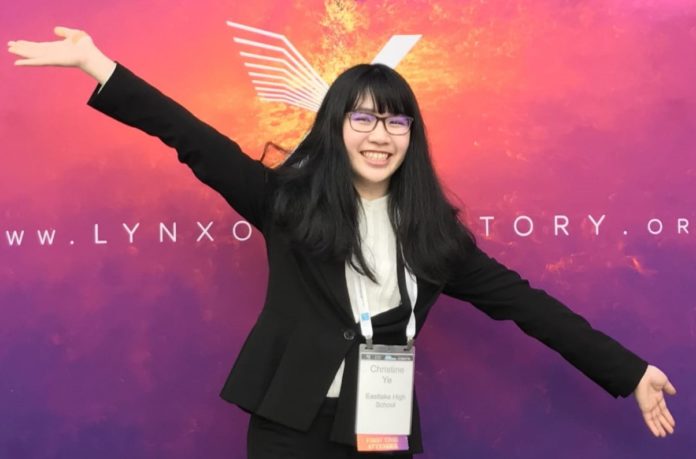
Christine Ye, a senior at Eastlake High School in Sammamish, Wash., has won the top award in the nation’s oldest and most prestigious competitions for science students, thanks to her research into the mysteries of black holes and neutron stars.
“I’m totally in shock,” the 17-year-old told GeekWire after winning the $250,000 first-place award in the 2022 Regeneron Science Talent Search. “It feels amazing.”
Ye was among 40 finalists honored on Tuesday in Washington, D.C., during a live-streamed awards ceremony that was emceed by “Saturday Night Live” cast member Melissa Villaseñor. More than $1.8 million in all was awarded to the finalists, who were evaluated on the basis of their projects’ scientific rigor and their potential to become scientific leaders.
Ye’s award-winning research is based on an analysis of readings from the Laser Interferometer Gravitational-wave Observatory, and addresses one of LIGO’s most puzzling observations.
In 2019, researchers at LIGO and at Europe’s Virgo gravitational-wave observatory detected ripples in spacetime that were caused by the collision of a black hole and a mystery object that was 2.6 times as massive as our sun. The mystery object’s size fell into a “mass gap” between the heaviest known neutron star and the lightest known black hole.
The analysis conducted by Ye and her co-author, Northwestern University postdoctoral fellow Maya Fishbach, determined that rapidly spinning neutron stars could get as massive as the mystery object. Their study will be the subject of a presentation next month in New York at a meeting of the American Physical Society.
It’s not possible to say definitively whether the object was a neutron star, Ye said, because “we don’t really know how fast it was spinning.” And because the two objects are now a single black hole, there’s no way to do follow-up observations.
“But my work does show that it’s possible, and that’s one way to explain it,” she said.
Ye said her opportunity to work with scientists at Northwestern University and with another team of researchers at the University of Washington at Bothell has been a “once-in-a-lifetime experience” that she’d recommend to other high-school students.
She still hasn’t decided where she’ll go to college after this spring’s graduation from Eastlake High, but she’s looking forward to focusing on physics and astrophysics — and wherever she ends up, the $250,000 will go a long way toward supporting her continuing education.
Working in gravitational-wave astronomy has been especially rewarding. “It’s a very young field,” she said. “It’s really nice to grow up with the field as it evolves.”
This year marks the 80th anniversary for the Science Talent Search, which is presented by the Society for Science and Regeneron Phamaceuticals. Here’s a quick rundown on this year’s other top award winners:
- Second place: Victor Cai, 18, of Orefield, Pa., won $175,000 for creating a short-range, narrow-bandwidth radar that calculates distance by transmitting two signals at different frequencies and then measuring the phase difference between them.
- Third place: Amber Luo, 18, of Stony Brook, N.Y., won $150,000 for developing a software platform called RiboBayes to identify key regions known as “ribosome pause sites” along mRNA transcripts that regulate protein synthesis.
- Fourth place: Daniel Larsen, 18, of Bloomington, Ind., won $100,000 for answering an important math question about the abundance of Carmichael numbers, which resemble prime numbers but are not true primes.
- Fifth place: Neil Chowdhury, 18, of Bellevue, Wash., won $90,000 for creating a computer model to study the role of a histone protein implicated in colon cancer. Chowdhury found that the histone caused changes to two key processes regulating the way DNA folds itself to fit into the nucleus of cells.
- Sixth place: Aseel Rawashdeh, 17, of Austin, Texas, won $80,000 for incorporating essential oils into baker’s yeast microcapsules to create an inexpensive method to kill the larvae of mosquitoes that spread viral illnesses.
- Seventh place: Pravalika Gayatri Putalapattu, 17, of Centreville, Va., won $70,000 for designing a video-assisted workflow recognition program to monitor laparoscopic gall bladder surgeries in real time, verify the surgeons’ actions, and flag errors so immediate corrective action can be taken.
- Eighth place: Neil Rathi, 17, of Palo Alto, Calif., won $60,000 for identifying common linguistic patterns in four languages that support the theory that human language evolved for greater efficiency in communication.
- Ninth place: Amara Orth, 18, of Glenwood, Iowa, won $50,000 award for eavesdropping on her family’s honeybees so she could identify the changes in vibroacoustic patterns in each hive and assess the hives’ health.
- Tenth place: Luke Robitaille, 18, of Euless, Texas, won $40,000 for using the mathematical concept of topological entropy to study simple braids.
- Seaborn Award: Hailee Han Byur Youn, 17, of Roslyn, N.Y., was chosen by her fellow finalists to speak on behalf of the Science Talent Search Class of 2022.
All other finalists received $25,000 each. In addition to the finalist awards, 300 top scholars and their schools were awarded $2,000 each in January during an earlier phase of the competition.





